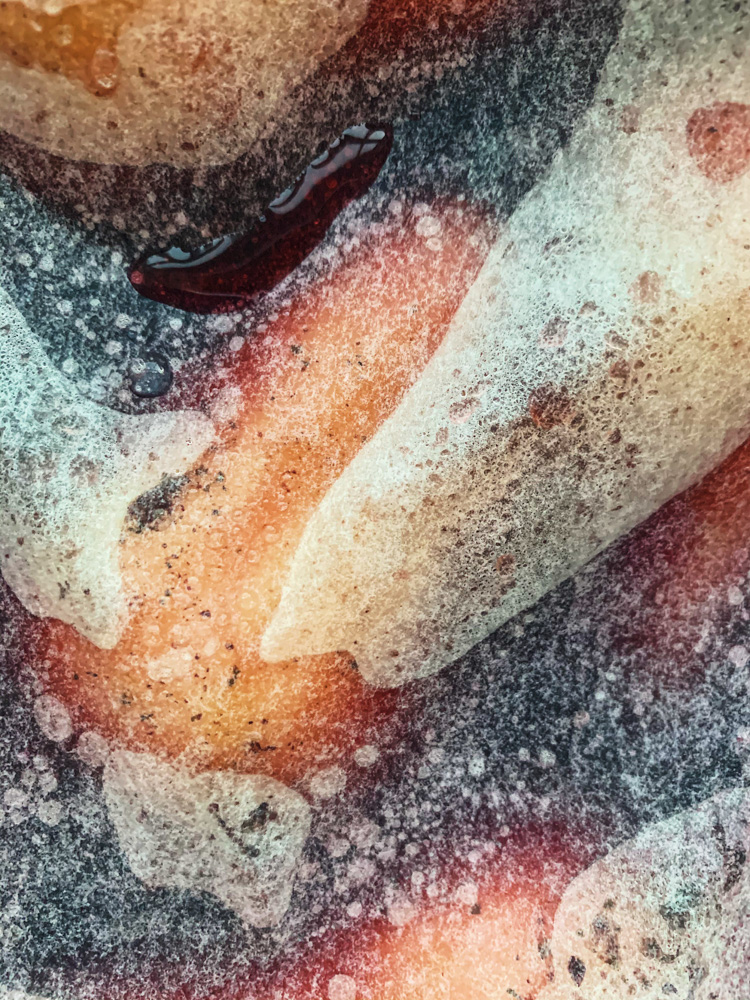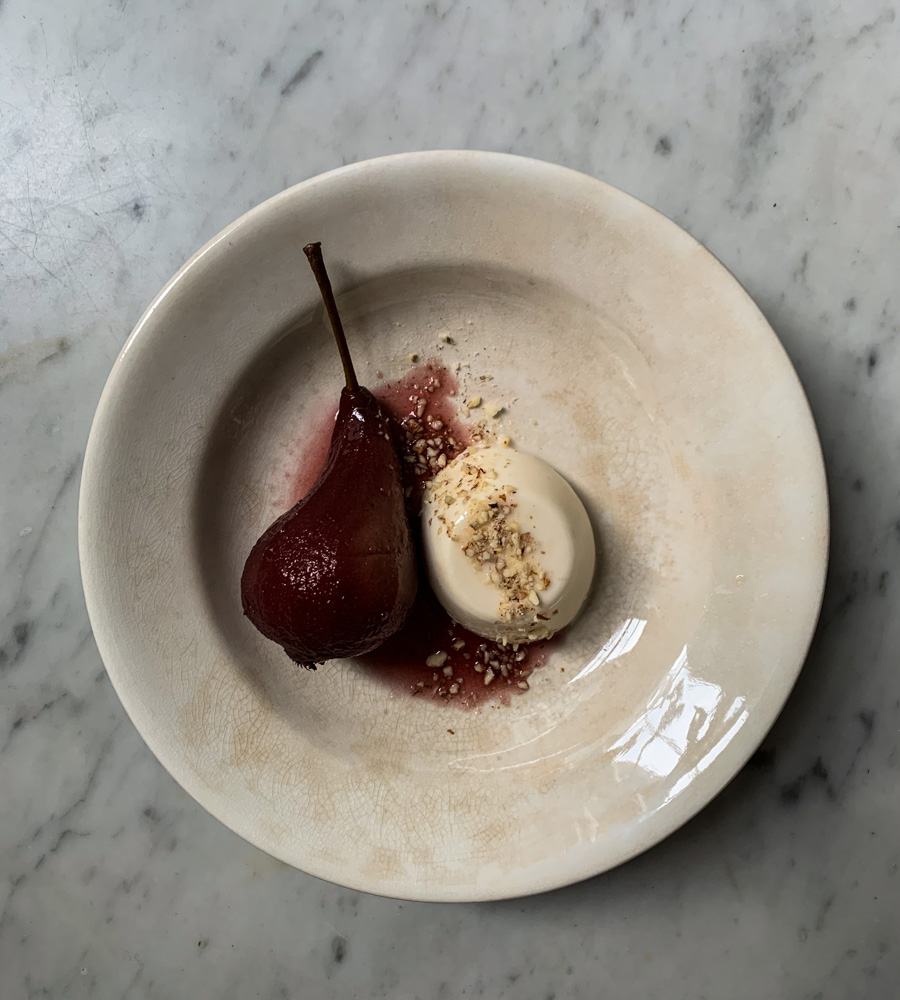
Ambrosia
Pears are on the stove poaching beneath a layer of parchment. I can see the liquid, now red from dried roses and haskap berries, bleeding to the top and clinging to the paper. Earlier I put a single star anise in the poaching liquid and I’m regretting it. Star anise is such a bossy spice. The line is fine between a syrup with *a hint* of liquorice and full-powered cough syrup. I cross my fingers.
The next day, as the pears stand in their deep red liquid, I make panna cotta. There’s no occasion, and in truth, no time. But this is what cravings do to people. And I have all the ingredients – milk, cream, a little sugar, almonds (an addition from the Zuni Cafe cookbook) and as you know, gelatine. And besides, I wanted to pull my gelatine relationship back into a subtle, delicate place. Water-proofing yourself with full strength gelatine and pool-worthy make up for a synchro costume will do that to a person. It doesn’t help when your own father reportedly spots a picture of you in a newsletter and thinks it’s a drag queen. I’m going for just a few tablespoons of gelatine this time. I want a slight wobble from this powder, not hard crack.
The craving began last week when I travelled to Wolfville for the Devour Food and Film Festival. Every fall movie and food lovers descend upon this University town to meet visiting chefs, filmmakers and to eat their food, watch their movies, take workshops and set off on wild food expeditions. (Last year I wrote about my foraging adventures here). Wolfville in the autumn, with its streets of gold, is the perfect backdrop.
We began the evening at a screening of Stanley Tucci’s 2006 film Big Night. ‘The internet’ describes the movie this way:
The brothers Primo and Secondo have come from Italy to America in hopes of running a successful, authentic Italian restaurant in 1950s-era New Jersey. Unfortunately they discover that they have an awful lot to learn about business in the New World. Much to their surprise, their newly opened Paradise Restaurant is not flooded with customers. The one customer they do have is unable to appreciate Primo’s exquisitely prepared risotto because there is no spaghetti and meatballs on the side. When Primo hears this, he nearly becomes apoplectic with rage and Secondo must hastily try to mediate between the woman and his angry brother to whom he explains the philosophies of American business. Primo doesn’t understand why the vulgar Americans would much rather eat the bastardized Italian foods…
The movie is like a stage play, where the actors move through the restaurant, cooking, talking, wishing, hoping, loving and misunderstanding, all while Chef Primo quietly cooks beautifully complex but simple food from his region in Italy.
After the film we sat down to a four course Italian meal, designed to celebrate Big Night. The dinner took place in a building that usually houses the Wolfville Farmers Market, but that night, there were fairy lights strung through the rafters and tables were set. In the corner a make-shift kitchen had been set up, where four female chefs from around the world were each preparing a course to serve that night:
- Ricotta cavatelli with hot Italian sausage, broccolini, basil and tomato pepper sauce by Melissa Kelly of Primo in Rockland, Maine
- Risotto with Ciro’s asiago, snow crab, fennel salad and crispy guanciale from Renée Lavallée of The Canteen, Dartmouth
- Devilled chicken, smoked barbecue sauce, Roman broccoli, threads of red hot chilli pepper from Paola Colucci of Pianostrada Laboratorio di Cucina in Rome
- and finally, the softest, creamiest, most flavourful panna cotta with pears poached in local grappa from Alida Solomon of Tutti Matti in Toronto
It’s rare for a four-course meal made by multiple chefs to flow like one, beautifully produced album where each song leads you to the next. So often chefs at dinners like these are male, showcasing a piece of beef, course after course. But tonight was different. It was varied in colour and texture. It was delicate but satiating. It was elegant. It was feminine.
Our table was a rowdy one, made up of a food blogger, a restaurant owner, my artist aunt, a DJ, an engineer and a food lover. But when the panna cotta arrived, everyone fell silent. A few gently shook their plates and watched how the creamy mound moved, but wouldn’t fall. When a custard is just set this perfectly, it tastes like velvety cream, suspended.
Aunt Sandra put a name to it: ambrosia. The OED defines ambrosia as food for Greek Gods, raised to the heavens, or something extremely pleasing in taste or smell. I thought of Primo, the older brother in Big Night, lovingly preparing his risotto in a huge copper pot, ladling rich, seafood-infused stock into the rice, gently stirring as each grain absorbed the flavourful liquid. This was ambrosia. But was it feminine? Not in a gendered sense. I’m talking about subtlety. Complex, but understated.
Food that doesn’t need spaghetti and meatballs on the side.
I went home and immediately began poaching pears. I was going for feminine. Subtle. Complex, but understated. This is why I worried about the star anise. I didn’t want bossy. I didn’t want drag queen. I wanted Primo’s ambrosia, something ‘extremely pleasing in taste or smell’. I wanted my Dad to recognize this food, even just a little bit.

Panna Cotta, from the Zuni Cafe Cookbook
4 x 5 ounce (125-ish ml / 1/2 cup) panna cotta cups – I used much smaller cups, below. Use what you have.
1/4 cup (30g / 1 oz) raw almonds
3/4 cup (180ml) whole milk
1 cup (250ml) whipping (heavy- 35%) cream
2 tablespoons plus 1 teaspoon sugar
a pinch of salt
2 tablespoons water
1 1/2 teaspoons unflavoured gelatine
Preheat oven to 325F / 160C
In the words of Zuni… “Spread the almonds (or hey Annabelle why not pecans?) on a baking sheet and toast lightly, about 10 minutes. They should be fragrant and just beginning to change colour on the inside. Chop immediately and place, still warm, in a small saucepan with the milk and about half of the cream. Add the sugar and a pinch of salt and stir as the mixture comes to a simmer. Remove from the heat and leave to infuse for about 10 minutes.
Rewarm the milk-almond mixture until it is hot to the touch. Measure the water into a small mixing bowl and sprinkle with the gelatine. Stir gently and leave to soften for about 3 minutes. Pour milk mixture through a fine strainer into the gelatine and water. Stir until the gelatine in fully dissolved. Add the remaining cream. Taste. It should seem a bit sweet; chilling will correct the imbalance.
Pour into four 4-5 oz ramekins. Tent with plastic and chill for at least 6 hours. The panna cotta will have the nicest texture if served within 6-12 hours; the gelatine will continue to set for up to 24 hours.
To serve, place each ramekin or custard cup briefly on a warm burner, then slide a knife cleanly around the edge (dipping cup into a bowl of very hot water also works). Invert onto a plate, and, holding cup in place on the plate, rap the ensemble gently on the counter, then leave for a minute to give the panna cotta a chance to slide out.”
I served my panna cotta with a single poached pear, some poaching liquid and a sprinkling of ground almonds. There are countless ways to poach pears. I winged it by making a syrup first of 1 part white sugar and 3 parts water ( 265g sugar to 800ml water). I brought it to a boil along with 40g of loose haskap and green tea and wild rose petals mixed together – I was going for vibrancy here. I simmered the mixture for 15 minutes, then strained it through a sieve. I poured the liquid into a sauce pan and added 3 tablespoons of lemon juice and 1 star anise (perhaps use a halved, broken piece if you’re going for something more subtle. The liquid was very good in the end, but the delicate rose flavour was lost). I brought it to a simmer.
As the liquid was simmering, I peeled 6 pears, added them to the liquid, covered the surface with parchment paper, put a lid on the pan and brought it all back to a gentle simmer. I let it simmer away for at least 15 minutes, until the pears were tender when pierced with a fork. I rolled the pears around from time to time, to make sure all sides were soaking in the liquid.
At this point I lifted the pears with a slotted spoon from the liquid and set them aside to cool while I continued to simmer the poaching liquid. Let it go until you have about 300 ml. Let that cool as well.
When both the pears and the liquid have cooled, store them together in the fridge overnight, rolling the pears around from time to time to make sure all surfaces are coated. There will be more pears than panna cotta, so be generous.
